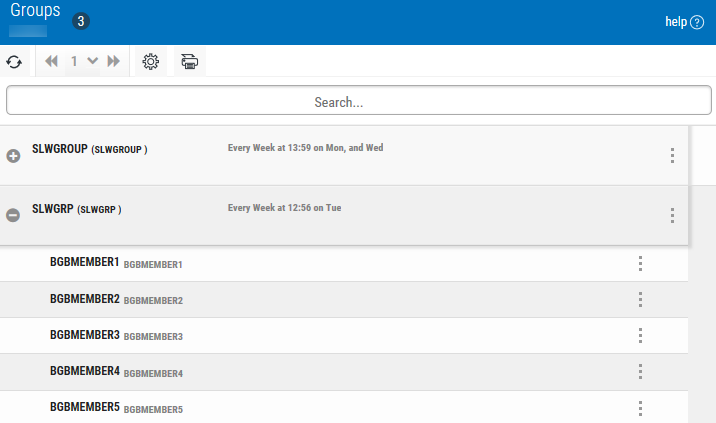Groups
You can group several jobs together under the control of a group control job. The group control job contains the run schedule for the group; it can also contain the control options for all jobs in the group. You can even apply schedule override codes at the group level.
The Groups page lists the groups that have been created in the Explorer or IBM i versions of Robot Schedule. It also lists the jobs that are members of each group.
Viewing Groups and Group Members
In the Navigation Pane, clicktap Groups under the Robot Schedule menu. If the menu is hidden, hover over the Navigation Pane to expand it.
Things to know and do:
-
The total number of groups listed and the server they're on is displayed at the top of the page.
-
To see a group's member jobs, clicktap
 Expand by the group name. ClickTap
Expand by the group name. ClickTap  Collapse to collapse the member list.
Collapse to collapse the member list. -
ClickTap
 Refresh to refresh the information in the display.
Refresh to refresh the information in the display. -
ClickTap the page number and select the page you want to view. Or, clicktap the previous and next arrows.
-
ClickTap
 Print Groups to view the list of groups and group members in HTML format. (Note: You may have to disable your pop-up blocker in order to view the report.) You can then print it using your browser's print function.
Print Groups to view the list of groups and group members in HTML format. (Note: You may have to disable your pop-up blocker in order to view the report.) You can then print it using your browser's print function. -
Start typing in the Search field to find a specific group. It will find every group name, group control job, and description that contains what you're typing. See Sorting and filtering below to learn how to filter your search.

You can take actions on both the group and the member jobs.
Actions you can take on the group control jobs:
ClickTap  Show Actions by any group to display the following actions that you can take:
Show Actions by any group to display the following actions that you can take:
- Select Do Job Now to submit the group control job for execution.
- Select Hold to place the group control job on hold. Only the group control job is affected. If one of its member jobs is scheduled to run outside of the group, it will still run.
- Select Schedule Override to override the normal run schedule and control the group control job manually. The page displays any override code that has been applied. These overrides only apply to the group control job, not its member jobs.
- Select Remove Override to remove a manual schedule override that has been applied. Only the override on the group control job will be removed. Its member jobs are not affected.
- Select Job Completion History to see the completion history for the group control job.
- Select Where Used to see where the group control job is used - whether it's part of another group, and whether it has any dependent jobs or prerequisite jobs.
- Select Diagram Job to create a job flow diagram for the group control job.
- Select Properties to display the group control job's properties.
Actions you can take on the member jobs:
ClickTap  Show Actions for any member job to display actions you can take. Depending on the job type and status, you'll have the following options:
Show Actions for any member job to display actions you can take. Depending on the job type and status, you'll have the following options:
- Select Start now with this member to start group processing at this member job.
- Select Hold in Group to place the member job on hold within this group. If the member job also has a standalone run schedule outside of the group, it will still run on that schedule.
- Select Override in Group to override the normal run schedule and control the member job manually. The page displays any override code that has been applied. These overrides only apply to the member job within the group. If the member job has a standalone run schedule outside of the group, that schedule still applies.
- Select Remove Override in Group to remove a manual schedule override that has been applied to this member job. Only the override that was applied within the group will be removed. Any override applied to this member job outside of the group will remain.
- Select Where Used to see where the member job is used - whether it's part of another group, and whether it has any dependent jobs or prerequisite jobs.
- Select Diagram Job to create a job flow diagram for the member job.
- Select Properties to display the member job's properties.
Sorting and Filtering the Display
There are settings for the Groups page that allow you to choose how to sort the list, and what types of data will be searched when you do a search.
Follow these steps:
-
ClickTap
 Settings.
Settings.
-
Select how you want the lists sorted (Sort By). ClickTap your selection again to change the sort order to
 ascending or
ascending or  descending.
descending. -
Select one or more options under Search By to narrow the list of items displayed.
-
ClickTap
 Settings to close the settings.
Settings to close the settings.